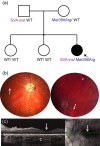Retrotransposon insertion as a novel mutational event in Bardet-Biedl syndrome
- PMID: 30484961
- PMCID: PMC6393654
- DOI: 10.1002/mgg3.521
Retrotransposon insertion as a novel mutational event in Bardet-Biedl syndrome
Abstract
Background: Bardet-Biedl syndrome (BBS) is an autosomal recessive pleiotropic disorder of the primary cilia that leads to severe visual loss in the teenage years. Approximately 80% of BBS cases are explained by mutations in one of the 21 identified genes. Documented causative mutation types include missense, nonsense, copy number variation (CNV), frameshift deletions or insertions, and splicing variants.
Methods: Whole genome sequencing was performed on a patient affected with BBS for whom no mutations were identified using clinically approved genetic testing of the known genes. Analysis of the WGS was done using internal protocols and publicly available algorithms. The phenotype was defined by retrospective chart review.
Results: We document a female affected with BBS carrying the most common BBS1 mutation (BBS1: Met390Arg) on the maternal allele and an insertion of a ~1.7-kb retrotransposon in exon 13 on the paternal allele. This retrotransposon insertion was not automatically annotated by the standard variant calling protocols used. This novel variant was identified by visual inspection of the alignment file followed by specific genome analysis with an available algorithm for transposable elements.
Conclusion: This report documents a novel mutation type associated with BBS and highlights the importance of systematically performing transposon detection analysis on WGS data of unsolved cases.
Keywords: BBS1; BBS; Bardet-Biedl syndrome; SVA; ciliopathy; human genome; mutation; repetitive element; transposable element.
© 2018 The Authors. Molecular Genetics & Genomic Medicine published by Wiley Periodicals, Inc.
Conflict of interest statement
The authors have no conflict of interest to declare.
Figures


Similar articles
-
A BBS1 SVA F retrotransposon insertion is a frequent cause of Bardet-Biedl syndrome.Clin Genet. 2021 Feb;99(2):318-324. doi: 10.1111/cge.13878. Epub 2020 Nov 14. Clin Genet. 2021. PMID: 33169370 Free PMC article.
-
Exploring genotype-phenotype relationships in Bardet-Biedl syndrome families.J Med Genet. 2015 Aug;52(8):503-13. doi: 10.1136/jmedgenet-2015-103099. Epub 2015 Jun 16. J Med Genet. 2015. PMID: 26082521
-
Genetic characterization of Italian patients with Bardet-Biedl syndrome and correlation to ocular, renal and audio-vestibular phenotype: identification of eleven novel pathogenic sequence variants.BMC Med Genet. 2017 Feb 1;18(1):10. doi: 10.1186/s12881-017-0372-0. BMC Med Genet. 2017. PMID: 28143435 Free PMC article.
-
Genetics of human Bardet-Biedl syndrome, an updates.Clin Genet. 2016 Jul;90(1):3-15. doi: 10.1111/cge.12737. Epub 2016 Feb 9. Clin Genet. 2016. PMID: 26762677 Review.
-
Bardet-Biedl syndrome with chorioretinal coloboma: a case series and review of literature.Ophthalmic Genet. 2024 Dec;45(6):616-622. doi: 10.1080/13816810.2024.2411257. Epub 2024 Oct 15. Ophthalmic Genet. 2024. PMID: 39402987 Review.
Cited by
-
Whole-Genome Sequencing in Diagnostics of Selected Slovenian Undiagnosed Patients with Rare Disorders.Life (Basel). 2021 Mar 5;11(3):205. doi: 10.3390/life11030205. Life (Basel). 2021. PMID: 33807868 Free PMC article.
-
Mechanisms of disease-associated SINE-VNTR-Alus.Exp Biol Med (Maywood). 2022 May;247(9):756-764. doi: 10.1177/15353702221082612. Epub 2022 Apr 6. Exp Biol Med (Maywood). 2022. PMID: 35387528 Free PMC article. Review.
-
A novel SVA retrotransposon insertion in the CHM gene results in loss of REP-1 causing choroideremia.Ophthalmic Genet. 2020 Aug;41(4):341-344. doi: 10.1080/13816810.2020.1768557. Epub 2020 May 22. Ophthalmic Genet. 2020. PMID: 32441177 Free PMC article.
-
LINE-1 ORF1p does not determine substrate preference for human/orangutan SVA and gibbon LAVA.Mob DNA. 2020 Jul 11;11:27. doi: 10.1186/s13100-020-00222-y. eCollection 2020. Mob DNA. 2020. PMID: 32676128 Free PMC article.
-
Non-reference genome transposable elements (TEs) have a significant impact on the progression of the Parkinson's disease.Exp Biol Med (Maywood). 2022 Sep;247(18):1680-1690. doi: 10.1177/15353702221117147. Epub 2022 Aug 23. Exp Biol Med (Maywood). 2022. PMID: 36000172 Free PMC article.
References
-
- Bellone, R. R. , Holl, H. , Setaluri, V. , Devi, S. , Maddodi, N. , Archer, S. , … Brooks, S. A. (2013). Evidence for a retroviral insertion in TRPM1 as the cause of congenital stationary night blindness and leopard complex spotting in the horse. PLoS ONE, 8(10), e78280 10.1371/journal.pone.0078280. - DOI - PMC - PubMed
-
- Billingsley, G. , Bin, J. , Fieggen, K. J. , Duncan, J. L. , Gerth, C. , Ogata, K. , … Heon, E. (2010). Mutations in chaperonin‐like BBS genes are a major contributor to disease development in a multiethnic Bardet‐Biedl syndrome patient population. Journal of Medical Genetics, 47(7), 453–463. 10.1136/jmg.2009.073205. - DOI - PubMed
Publication types
MeSH terms
Substances
LinkOut - more resources
Full Text Sources

